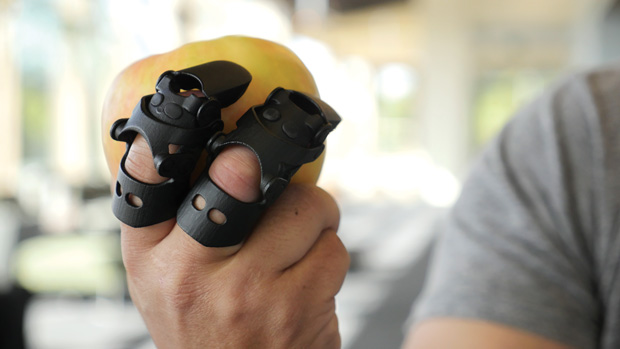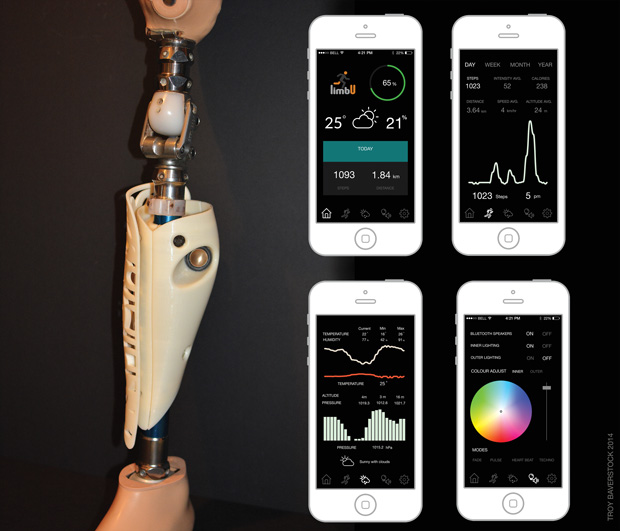
Naked Prosthetics uses 3D printing to create biomechanical prosthetic fingers, such as the PIPDriver, pictured here. Image courtesy of Naked Prosthetics.
Latest News
August 1, 2016
 Naked Prosthetics uses 3D printing to create biomechanical prosthetic fingers, such as the PIPDriver, pictured here. Image courtesy of Naked Prosthetics.
Naked Prosthetics uses 3D printing to create biomechanical prosthetic fingers, such as the PIPDriver, pictured here. Image courtesy of Naked Prosthetics.Today’s prosthetic applications are an example of the intersection of design, technology and science. Going beyond traditional molding techniques and labor-intensive processes presents new opportunities for medical device design and patient data collection.
Despite its long history, 3D printing is just now flourishing in the medical sector, especially for generating prosthetics. Engineers and medical professionals are collaborating on a new generation of technology and design processes based on the quick customization enabled by 3D printing.
“With the use of 3D printing, a designer and prosthetist can work together to design a prosthetic using modern tools in combination with age-old techniques like plaster casting, to create prosthetics faster and more efficiently at a lower cost,” says Ava DeCapri, industrial designer at FATHOM, a Stratasys 3D printer reseller and service provider.
For example, Travis Bellicchi, Maxillofacial Prosthodontic resident at Indiana University’s School of Dentistry, is working with a host of students and faculty to develop a new mandible prosthesis for a patient. They’re using a new digital workflow that includes 3D printing.
Knowing the final product would be produced with FDA-grade silicone, Bellicchi and his team decided to integrate 3D printing as part of the design process. “It’s easily iterative. If you’re working with plaster in the lab to make your molds, it’s quite easy to crack, fracture [or] get totally destroyed. There’s a real delicacy to a mold.” Additionally, there’s a higher resolution quality to some of the printing materials, which is especially important when figuring out how to place a prosthesis near a jaw or under skin.
To develop a new mandible, Bellicchi collaborated with the School of Informatics and Computing: Department of Media Arts and Science, School of Mechanical Engineering and Herron School of Art. Their work not only created a new mandible, but also produced a digital workflow that combined 3D scanning, CAD and 3D printing—something that’s relatively new to the field. “In the past, our work felt very traditional and bogged down in this analog process,” he says.
By being able to gather digital data and print multiple prototypes, Bellichi says his team was able to automate a lot of the time-consuming lab work by referring to patient data every time they wanted to tweak the design, instead of starting from scratch.
Collaboration is also helping to drive lower costs. “The largely open-source prosthetic 3D printing community shares designs and concepts at high speed, constantly 3D printing, testing and improving available designs … leading to faster innovation in the industry as a whole,” FATHOM’s DeCapri notes. This type of open-source design can be seen through organizations such as e-NABLE, The Helping Hand Project, Open Bionics and others who are focused on providing affordable and free 3D printed prosthetics to those in need.While one of the main benefits of using 3D printing for prosthetics is reduced cost, there are other benefits that might not immediately be considered. “There is less risk and lower cost involved in designing and creating 3D printed prosthetics vs. traditionally fabricated prosthetics, so the technology allows for greater exploration of unprecedented design concepts. For the many people who have unique cases, traditional options [which may require surgery] can seem overwhelming,” says DeCapri.
Beyond the cost and time savings for digital development, Bellicchi hopes using tools such as 3D printing and basic design software could also help medical professionals directly within hospitals. “There’s a missing link in healthcare [when it comes to] digital design. Day-to-day, there’s a need for more simplistic rapid prototyping that doesn’t necessarily justify the thousands of dollars of design support, but still can be beneficial for patients.”
Getting Technical
3D printing is just the beginning of offering customized medical devices. Affordable, accessible technologies are also ushering in an era of prosthetics and medical devices that integrate sensors for smart prosthetics and tailored feedback. Some examples include the BOOMcast from FATHOM and the limbU design. Both of these applications focus around connecting technology and augmenting the patient’s use of a prosthetic or cast.
“With BOOMcast, the FATHOM team saw the opportunity as a challenge,” DeCapri explains. “How can we rethink a medical cast? What are the possibilities that haven’t been tapped into? What if this leg cast could actively facilitate the healing process and give doctors additional medical data?”
Some of the technology that was used in the BOOMcast was implemented to gather technical data—including an accelerometer, gyroscope, magnetometer and an Intel Edison compute module. Because the wearer, Mike North, was constantly moving around the globe for his job, having connectivity allowed doctors assess his medical state from afar and make adjustments as needed.
While the technology helped doctors monitor patient statics, it also served as a bigger part of the user experience. Bluetooth-enabled speakers and LED lighting added a new layer of customization. But, it wasn’t entirely decorative; the speakers emitted low-frequency tones that researchers concluded did ultimately help heal the bone, says DeCapri.
The integration of different technologies such as 3D printing, sensors and computer processors is just the beginning for prostheses.
“Despite promising advances in medical technology, prostheses that can match their biological counterparts are currently confined to the realms of science fiction. This limitation, however, does not restrict us from exploring new forms and functions for which the prosthetic limb is uniquely situated,” says Troy Baverstock, designer.
 The limbU prosthetic device integrates sensors and lights for data collection and customization. Image courtesy of Troy Baverstock.
The limbU prosthetic device integrates sensors and lights for data collection and customization. Image courtesy of Troy Baverstock.Baverstock has designed limbU to push the boundaries of prosthetics and advance the current offerings. The device, which is a prosthetic add-on, currently sports a USB charger, stereo amplifier and speakers, GPS, microcontrollers, barometer, accelerometer and gyroscope. Ultimately, the wearer will not only be able to monitor daily activity, but also their environment around them. “limbU seeks to redefine a wearer’s relationship with their limb by allowing the opportunity to co-create its form and function to suit their personal lives,” he says.
But, even with these advanced devices, Peto says that the technology for truly advanced prosthetics right now is currently ahead of the implementation. Still, with the lower costs of 3D printing methods and the trend toward connectivity, it’s helping more patients get better devices and paving the way for even more innovative prosthetics.
More Info
Subscribe to our FREE magazine, FREE email newsletters or both!
Latest News
About the Author
Jess Lulka is a former associate editor for Digital Engineering. Contact her via de-editors@digitaleng.news.
Follow DERelated Topics






